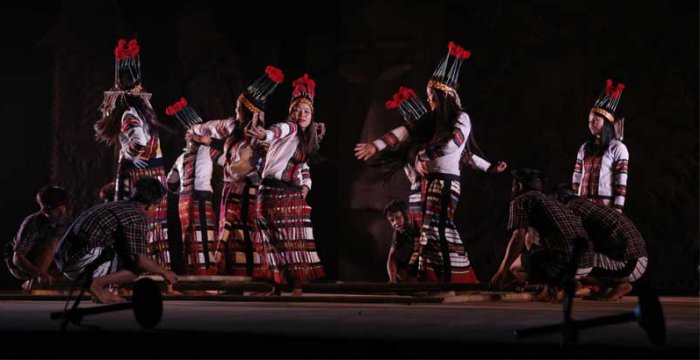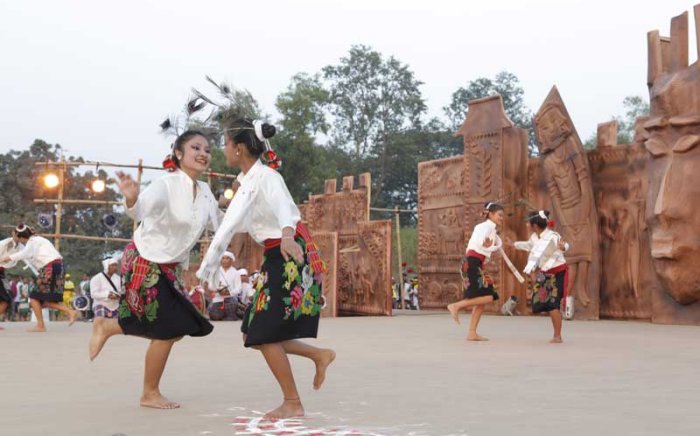 |
 |
Adivasi Adibimb Festival at Chaibasa - Tapati Chowdhurie e-mail: tapatichow@yahoo.co.in December 5, 2016 Ratan Thiyam’s abiding interest in seeing life in its true colours has not allowed him to sit quietly and just be an onlooker of the happenings of the times. To seek truth and beauty is the work of an artist. And an artist he is. Eternal art cannot be built on falsehood. Anything that deviates from truth and subsequently beauty, pains the artist and you see his outpouring of protests in the highest forms of aesthetic beauty. Modern man in their struggle to be civilized has succeeded in reaching great heights through technological progress, which has given him artificial energy. Plush accommodations, swanky cars, expensive clothes, luxurious and upmarket seven starred hotels have come under the reach of many. The ultimate result of which is dwindling of the earth’s resources. Today the cry is to save nature for the generations to come. Ratan Thiyam who plays many roles as an artist, has not blurred his vision in the plight that besets us. He has embarked upon a soft protest by highlighting the lives of the tribal people of the country-the original inhabitants - who live in amity and harmony with nature. He has therefore launched the Adivasi Adibimb festivals not in cities, but in those parts of the country where they live and are easily accessible to them. More than ever these festivals have thrown light on their ways of living, their customs, traditions and practices, which have greatly been neglected. Starting from the anniversary of the 17th Statehood day of Jharkhand, where a number of tribes live, National School of Drama under the aegis of its Chairman, Ratan Thiyam, held a three day long Adivasi Adibimb Festival at Chaibasa (15th to 17th November). 15th November was specially chosen because it was the birth anniversary of Birsa Munda, who to the adivasis is a god and who to the British colonial rulers was a troublesome freedom fighter who needed to be flushed out forthwith. At least 300 hundred folk artists from 32 indigenous tribes of India came to Chaibasa and entertained the assembled city dwellers and the tribal audiences with their outstanding performances. The objective behind the festival was to help different tribal groups to interact with each other and understand their place and importance in the country. It also aimed at creating a general awareness amongst the public to know more about these groups, who share the resources of the earth along with them, albeit a little more judiciously.  Naga dancers  Karma dancers, Jharkand The Tiwa community of Assam performed Barat dance. One was witness to the dance performed during the Barat Loka Festival, where the Pati Dhulia dancers and singers from Tiwa villages dance in the foothills of Tetelia during the full moon night of the winter season in the presence of the king. The Seng, Murikh, a kind of Sehnai and Pongi - a huge flute - was played and the Karbi tribe sang and danced to show the kind of wit they exchange before the cultivation season. There were musical instruments that are not often seen and this was quite a spectacle. Rich in culture the Mizo Chheih Lam dancers ushered in a joyful spirit. They were accompanied by a kind of song known as the Chheih Hla. The song was rendered to the beat of the bamboo and hand clapping. Some formed a circle and sat on the floor while the dancer stood in their midst and recited pieces and danced. As there was no specific choreography, in the course of the recitation and dance, those who sat joined in and together they danced in ecstasy. This is their traditional kind of relaxation after the day’s work. Then there was the very popular bamboo dance (bamboo grows abundantly in the rain forest hilly region of Mizoram) where the dancers moved in and out from between and across a pair of horizontally laid bamboo. Hearsay has it that this was customarily performed to ensure a safe passage of a mother to heaven, who died at child birth. Ghumura which is a traditional heroic dance of Kalahandi district of Odisha was danced to the accompaniment ghumura, nisha, dhol, taal and madal. This dance was a kind of morale booster for folks going to war. Bajasal, a rich variety folk dance of Odisha performed during marriages was showcased too. Gubukudu, the ancient and primitive tribal dance of Odisha which used to be a means of subsistence for the poor tribes, was danced to the accompaniment of gubukudu, which is a kind of stringed instrument made by the savars. The festival also provided the audience a chance to see the Honrei Kasui and Yara Pheichuk dance of Manipur.  Tai Khamti Peacock dancers  Dong dancers Khamti dancers of Lakhimpur performed the Peacock Dance. The peacock for the Khamtis symbolizes love, harmony and peace on earth. Tribes from Katihar, Bihar danced a traditional dance they perform during marriages. The Baha dancers heralded spring. Mongchaoaks of Sikkim performed a dance to show how they harvest millet. Then there were performances of Maanbhum Chhau, Oraun Nritya, Mundari Nritya, Baha Nritya, Kurmali Ho, Bhumij Nritya and several other varieties of tribal dances. According to Assistant professor of Sociology “Ratan Thiyam is the messiah of the neo-tribal movement in our national history. He is a champion of neo-tribal rights and their claims.” Tapati Chowdurie learnt dance for almost 10 years from Guru Gopinath in his dance institution Natana Niketan in Madras. For a brief period, she was with International Centre for Kathakali in New Delhi. Tapati has a Master's degree in English Literature and Bachelor's degree in Education. She has a regular column in The Statesman, where she writes on dance and music. She also writes for The Hindu and Sruti. Presently, she is a freelance writer. |